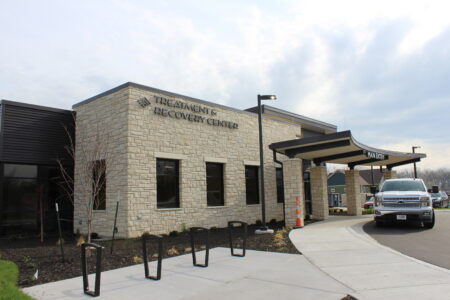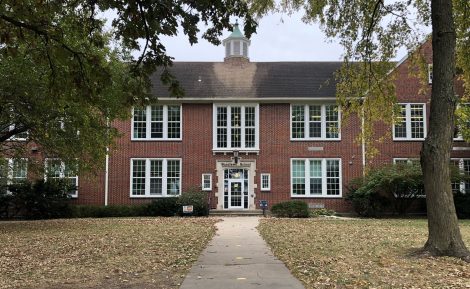Opening date is still unclear for the Treatment and Recovery Center of Douglas County

photo by: Austin Hornbostel/Journal-World
The Treatment and Recovery Center, located on the Treatment and Recovery Campus of Douglas County at 1000 W. Second St., is pictured on Friday, April 15, 2022.
The Treatment and Recovery Center of Douglas County should soon be officially licensed, but it’s still unclear when exactly it’ll be ready to open.
The center’s executive director and medical director, Dr. George Thompson, told the Journal-World Thursday afternoon that a majority of the pieces were in place. The final operational roadblock is licensing and, as Thompson tells it, that’s a box that will be ticked in less than a month’s time.
“We should have our license by Nov. 1,” Thompson said.
But there isn’t an opening date in sight at this point. Thompson stressed that he’s not the only one making decisions related to the Treatment and Recovery Center — Behavioral Health Partners Inc. is contracted by the county to govern the center. Those two entities, he said, work together and are ultimately in charge.
On that front, Douglas County Administrator Sarah Plinsky told the Journal-World Friday afternoon that there wasn’t an opening date at this time. Plinsky said the county was still working toward identifying a date and sharing it with the community, but that county leaders would discuss what needs to happen to get there in more detail during a presentation about the center at the Douglas County Commission meeting on Oct. 12.
Back when the commission first approved the financial plan for the facility in October of 2020, county officials said they expected construction would be complete by the end of last year. That didn’t end up being the case until June, when the county hosted a ribbon cutting for the building but shared that there wasn’t a set date to begin operating.
However, Thompson said there aren’t any other big hurdles in the way of opening.
“Everything that we’re doing is designed to make sure that we’re in good hands,” Thompson said. “… It’s mostly a feeling, that ‘I’m in good hands. (The center’s staff) are confident, they’re compassionate, they want to understand me, and they can help.'”
Around 30 staff members are working out of the center now, Thompson said. Another 50 nurses and behavioral health specialists are seeing patients at LMH Health, and around 20 staffers are doing the same thing across the street at Bert Nash Community Mental Health Center. That accounts for at least 90% of the staff Thompson said he anticipated the center would need.
Thompson also said 134 out of roughly 170 internal policies were on the books for the Treatment and Recovery Center, with another 30 drafted.
Beyond those metrics, Thompson said it was also important to him to get a stamp of approval from Connections Health Solutions, the crisis response center in Arizona that the Treatment and Recovery Center is modeled after. He noted that he speaks with the leaders of that facility on a weekly basis.
Thompson said it’s clear that there’s a lot of community interest in the status of the center. He’s even seeing it in his hiring process.
“There have been four psychiatrists that have called and asked if they can work here,” Thompson said. “That’s crazy. I have never had a psychiatrist call and say, ‘Can I work at your place?'”
Thompson said he’s also been deliberate about talking with as many community stakeholders as he can in the meantime, meeting with leaders with local law enforcement agencies and emergency medical services.
“The way I think about it, like why is this taking so long? (It’s because) we’re not just building a crisis center; we’re building a crisis system,” Thompson said.
•••
As far as background on why the center still isn’t open, Thompson said it starts with the passage of a 2017 Kansas statute called the Crisis Intervention Act, which allows for the creation of a “crisis intervention center” that can accept involuntary patients. That would include restraining or administering medications or other treatments to those patients without explicit consent, only if those options are deemed necessary and in line with accepted clinical practice. Thompson said that might apply to patients who come to a facility like the Treatment and Recovery Center acting more aggressively while under the influence of drugs, for example.
That’s in line with other functions of Douglas County’s facility, like being able to accept voluntary patients at the facility’s “access center,” which is open during a regular set of business hours, or to hold patients for longer periods in the 23-hour observation room or 72-hour stabilization unit. Thompson explained those spaces to the Journal-World in more detail earlier this year.
The Crisis Intervention Act called for the Kansas Department for Aging and Disability Services to write regulations and develop a licensure process, Thompson said, but they’ve yet to be “promulgated” — or proclaimed publicly, which is how rules and regulations formally take effect — beyond draft versions. That meant they wouldn’t cut it for allowing the Treatment and Recovery Center to do the work it needs to.
What county leadership did find out, Thompson said, was that the center could get licensed as a “private psychiatric hospital.” It’s not exactly the right licensure in the long term, but he said it did function as a stopgap so the center could open and have the ability to function the way it’s intended to right away. The move wasn’t one without questions, though.
“Can we do both mental health and substance use together?” Thompson said, for example. “Can we take involuntary patients? All of the things we want to do, does it allow us to do what we want to do, and what does it require us to do?”
But pursuing that licensing required a pivot. Leadership with the center had, for months, been trying to get licensed as a crisis intervention center. By around June, Thompson said, they were looking into the private psychiatric hospital license, and all of the materials for that license application were submitted by Aug. 2. With that, Thompson said a 90-day window started for the state to process the completed application.
“We’ve gone through all of these hoops,” Thompson said. “Actually, I think we went very fast, from June 6 to Aug. 2. From ‘Hey, we want you guys to be licensed as a hospital’ to actually them telling us ‘Your hospital license application is complete.’ … I think we’ve done well in that standpoint.”
It’s supposed to be a temporary fix, Thompson noted. The center will eventually be aiming to get licensed as a crisis center, since it isn’t hoping to meet the state’s definitions of “hospital standards” in the long term. Those definitions generally ask more of a facility, Thompson said, and make it tougher to outsource things like pharmacy services to other licensed hospitals such as LMH Health.







